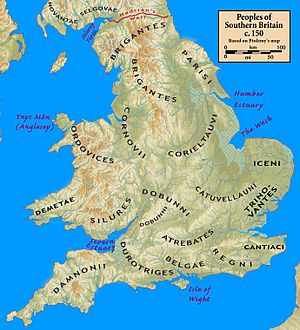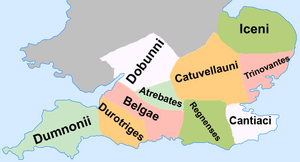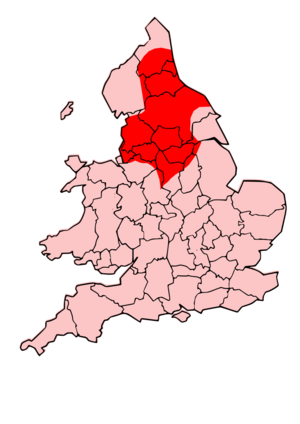Roman client kingdoms in Britain facts for kids
The Roman client kingdoms in Britain were groups of native tribes. They chose to work with the Roman Empire. This was often because they wanted to protect themselves. Sometimes, they needed protection from other strong tribes. The Romans also set up these kingdoms when they wanted to have influence without directly ruling an area.
These kingdoms were led by special leaders called client kings. In Latin, they were known as rex sociusque et amicus. This means "king, ally, and friend." How Rome and each kingdom worked together depended on their unique situation.
This system started when Julius Caesar helped Mandubracius become king of the Trinovantes tribe again. Mandubracius had been removed from power by Cassivellaunus. He then helped Caesar during his second invasion of Britain in 54 BC. Over the next 100 years, especially under Augustus, more client kingdoms formed. By the time the Romans fully invaded Britain in 43 AD, several were in the south. Rome would take over a client kingdom if they needed to show their power. They also took over if the client kings could no longer manage their areas.
Some kingdoms formed because the Catuvellauni tribe grew stronger under Cunobelinus. Others were a direct result of the Roman invasion. Important client kings included Cogidubnus of the Regni, Prasutagus of the Iceni, and Cartimandua of the Brigantes. It is also likely that Boduocus of the Dobunni was a client king. The Atrebates tribe, who were ancestors of the Regni, had been Roman client kingdoms since Caesar's first invasion in 55 BC. In northern Britain, ongoing fights near the Roman walls led to "buffer states." These were like protective zones, and one example was the Votadini in Northumberland.
Contents
How Rome Set Up Client Kingdoms
Julius Caesar invaded Britain in 55 BC and again in 54 BC. His first invasion was not very successful. The Celtic tribes of Britain fought harder than he expected. The 54 BC invasion was seen as a success. However, Caesar felt the island did not offer much reward. He left without leaving any soldiers to guard his new conquest.
Client kingdoms first helped the Roman army under Emperor Claudius. Later, they became a way for Rome to become a powerful, unified empire. Each kingdom had its own ways of working with Rome. This was especially true for trade and defense. They also created a national identity that fit with Roman ideas.
Some client kingdoms, like the Catuvellauni and Iceni, rebelled against Rome. The relationships between the client kingdoms and other Celtic tribes changed often. Loyalties shifted between the native people and the Roman invaders. These changing political ties led to fights. For example, the Atrebates and Catuvellauni fought in 40 AD. The Brigantes tribe and the Catuvellauni also had conflicts in 50 AD.
Key Client Kingdoms
Southern Britain's Client Kingdoms
Trinovantes and Catuvellauni Tribes
- Client Status: 54 BC to about 39 AD
- Location: Lands in southeast England
In 54 BC, Julius Caesar made Mandubracius of the Trinovantes a client king. He also made the Catuvellauni a state that paid taxes to Rome. These client kingdoms in southern Britain started to look like one British society. The Catuvellauni largely ruled this area. Old coins show that Cunobelinus ruled both areas from about 10 AD until 39-40 AD. After he died, his son Caratacus led groups that were against Rome.
In 40 AD, Caratacus took over the Atrebates client kingdom. Its king, Verica, was a friend of Emperor Claudius. Caratacus led forces against the Roman invasion in 43 AD. He was later recorded fighting against governor Publius Ostorius Scapula in 50 AD. He fought with tribes from Wales. This led to his defeat in 50 AD. He then sought safety with the Brigantes. However, Queen Cartimandua betrayed him in 51 AD. After Caratacus' defeat, the Catuvellauni lands became part of the Roman Empire. The town of Verulamium became a municipum in 50 AD. Its people gained some Roman citizenship rights.
Atrebates, Later Regni or Regnenses
- Client Status: 55 BC to 70s AD
- Location: Roughly modern-day Hampshire and West Sussex (capitals now Silchester and Chichester)
The Atrebates were a Belgic tribe. Their semi-independent client king, Commius, was in Gaul when Caesar left Britain. Commius started to plot against Rome. He was forced to escape to Britain in 54 BC. He declared himself king of his people. He ruled until about 20 BC.
Commius's three sons followed him as rulers. First was Tincomarus, from 25/20 BC to 7/8 AD. He was more friendly to Rome than his father. Coins show he called himself rex, meaning he was a client king under the Roman Empire. He was forced out in 7/8 AD and sought safety with the Romans.
After Tincomarus, Emperor Augustus chose his brother, Eppillus, as the next client king. Eppillus had ruled with Tincomarus. He became the sole ruler around 7 AD. He might have been the one who drove Tincomarus out.
Another son of Commius, Verica, followed Eppillus. He ruled from Silchester. During his rule, the Atrebates faced pressure from the Catuvellauni to the east. Around 10 AD, Epaticcus, brother of Cunobelinus, removed Verica from power. Verica did not regain control until 37 AD. Caratacus of the Catuvellauni conquered the kingdom. Verica was driven out of Britain around 40 AD. As a Roman ally, it is believed that Verica helped convince Claudius to invade Britain when he sought refuge in Rome.
After the Roman conquest, Cogidubnus became a ruler. He was given the Roman names Tiberius Claudius. Cogidubnus ruled the lands of the Atrebates and the Regni. He used Regni as the new name for all the people in those regions.
Iceni Tribe
- Client Status: About 47 to 60 AD
- Location: Roughly modern-day Norfolk
The Iceni tribe lived in the southeast of Britain. They had their own coin system before the Roman invasion. These coins show that a king named Antedios was in power during Claudius's invasion in 43 AD. The kingdom rebelled in 47 AD when Rome tried to take their weapons. It is thought that Rome removed Antedios from power and made Prasutagus king.
When Prasutagus died in 60 AD, he wanted to give half his power to his daughters. The other half he wanted to give to the emperor. This went against Roman law. Roman law said the Iceni land would become part of the emperor's land. The Romans took control and treated Prasutagus's wife, Boudica, and her daughters very badly.
These actions started a big revolt across many British client kingdoms. This included the Iceni and Trinovantes. The revolt led to the destruction of the Roman towns of Colchester, Londinium, and Verulamium. These towns were quickly rebuilt after the revolt was stopped. The story of Boudica's death is a mystery, with different accounts. After Boudica's defeat, her and Prasutagus's territory became part of the Roman province.
Northern Britain's Client Kingdoms
Brigantes Tribe
Main Articles: Brigantes
- Client Status: About 46 AD onwards
- Location: Pennines of South Yorkshire to north of the Tyne
The Brigantes were given client status. They were not seen as a conquered Celtic tribe, even though they accepted Roman rule. Important leaders included Client King Venutius and Queen Cartimandua. Cartimandua was a powerful female leader, which was new to the Roman invaders. Cartimandua is known for betraying Caratacus after his rebellion in 51 AD. She handed him over to the Roman army.
This act caused trouble in the Brigantia areas of Britain. People were split between supporting Cartimandua and Rome, or supporting her husband Venutius and the British rebellion. Venutius then took control of the Brigantes tribe. He led his own rebellion against the Romans and his wife, Cartimandua. His supporters eventually forced Cartimandua out of her land because she betrayed Caratacus. This rebellion was defeated at a time that is not known.
Over the next 100 years, relationships with the Brigantes tribe changed. Fights and war broke out during the conquest by Gnaeus Julius Agricola. He was the governor of Roman Britain from 78 AD to 85 AD. Problems with the Brigantes tribe continued into the second century. This was during the building of Hadrian's Wall and Antonine Wall.
Votadini Tribe
- Client Status: About 140s to about 410 AD
- Location: Southeast Scotland and northeast England, including modern-day Northumberland
The Votadini were a Brythonic people. They lived under direct Roman rule between Hadrian's Wall and the Antonine Wall. This was from 138 to 162 AD. When the Romans moved back behind Hadrian's Wall in 164 AD, they left the Votadini as a client kingdom. This kingdom acted as a protective zone against the Picts in the north. They remained a client kingdom until the Romans left Britain in 410 AD. Over time, the Votadini's language changed. They became known as the Gododdin. They kept their kingdom until the Angles defeated them around 600 AD.
See also




